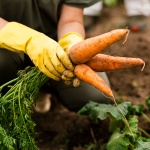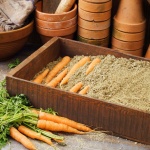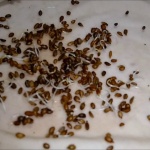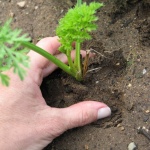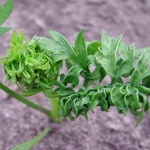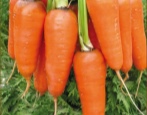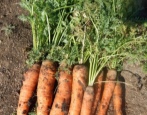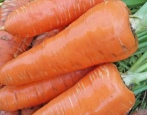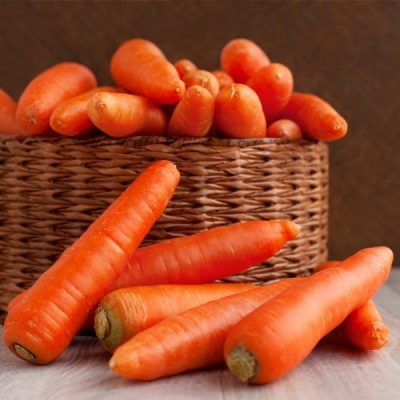
- Authors: Holland
- Appointment: for fresh consumption, for canning, for freezing, for making juice
- Weight, g: 100-120
- The form : cylindrical
- Taste qualities: excellent
- Ripening terms: mid-season
- Growing regions: north and central
- The size : large
- Length, cm: 12-20
- Diameter, cm: 3,5
When planning the planting of vegetables on the ridge, each gardener allocates space for carrots. Hybrid varieties of carrots are in great demand, characterized by unpretentious care, abundant yields and excellent taste. A striking example is the mid-season Nandrin carrot, which appeared in the Netherlands.
Breeding history
The Nandrin carrot is a hybrid bred by Dutch breeders at the Bejo Zaden seed company. The main task of botanists was to create a vegetable with a huge size, as well as with an increased level of sugar content and juiciness. Carrots are grown in different climatic zones of Russia, including the northern and central regions. You can plant a vegetable on a garden ridge, in fields, in greenhouse structures.
Description of the variety
The Dutch hybrid Nandrin is a vegetable crop characterized by a semi-erect rosette of leaves. Sometimes the rosette of the plant is absolutely vertical. The emerald green leaves are thick and tall. In general, the rosette grows powerful, strong, which undoubtedly simplifies harvesting. Carrots belong to the Nantes / Berlikum cultivar. A distinctive feature of the plant is its resistance to flowering (shooting).
Characteristics of the appearance of the plant and root crops
Nandrin belongs to the class of large-fruited varieties. The mass of the vegetable is 100-120 grams. The length of the carrot reaches 20 cm, and the diameter is 3.5 cm. The weight of the fruit directly depends on the duration of ripening. The shape of the root crop is aligned and neat - cylindrical with a rounded tip. The surface of the carrot is smooth, without cracks or other flaws. The color of the fruit is rich orange, sometimes with a reddish tint.
Dug / elongated root crops are easily transported over long distances, and also, despite the mid-early ripening period, have a long keeping quality. Under appropriate conditions, the vegetable can be stored for up to 7 months without losing its taste and marketability. It is recommended to store root vegetables in dry boxes with openings for air circulation at a temperature of + 3 ... 6 degrees.
Purpose and taste of tubers
The Dutch carrot variety captivates with its delicious taste. The bright orange pulp is endowed with a dense, fleshy and juicy texture. The root vegetable is very thin. The taste is harmonious, rather sweet, with a pleasant sugariness present. A feature of the variety is the high content of fructose, beta-carotene and a whole complex of vitamins in carrot pulp. In addition, the sugar content on the Brix scale is rated at 7.9.
The harvested crop is widely used in cooking - carrots are added to the first and second courses, pickled, frozen, used for canning vegetables, and also kept fresh until spring. Nandrin carrots are ideal for processing into healthy juice.
Maturation
The hybrid is a medium-ripening vegetable category. From the moment of emergence of mass shoots to the ripening of root crops, 100-120 days pass. The germination capacity of the culture is friendly. Harvesting is possible at almost any stage of ripening. The massive return of the crop occurs in August-September, but, if the weather permits, it lasts until mid-autumn.
Yield
High yield is one of the advantages of the Dutch hybrid. On a garden ridge from 1 m2 of plantings, you can get an average of 8-9 kg of juicy vegetables.When growing a root crop on farm land, usually 5-7 kg of vegetables are dug out from 1 m2. On an industrial scale, the indicator is as follows - 50-70 t / ha.
Growing regions
Today, sweet Nandrin carrots are massively grown not only in Russia - they have also gained popularity among vegetable growers in Ukraine, Moldova, and Belarus.
Growing and care
A vegetable crop is cultivated through sowing seeds. Landing is carried out, as a rule, in the second half of spring - late April, mid-May. It is important that carrot seeds do not require additional pre-planting treatment. Before sowing, special grooves are prepared in the soil. The distance between the rows is 50 cm. The seeds are deepened by 2 cm. The planting is carried out according to the 5x15 cm scheme. The best predecessors for Nandrin carrots are: cucumbers, onions, nightshade crops, cabbage.
Plant agrotechnology consists of basic procedures: regular and abundant watering (3-4 times during the ripening period), which stop 20 days before the mass harvest, fertilizing twice a season (the plant reacts well to mineral complexes), thinning (it is important that there was always a distance between the plantings), weeding after each watering, as well as the prevention of viruses.
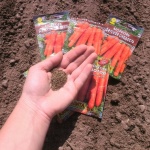
Carrots are one of the most unpretentious crops in terms of growing conditions; they can endure a short drought and a short cold snap. However, to get tasty and large root crops, you should adhere to the basic rules for planting carrots.

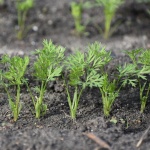
Soil requirements
For carrots, light, fluffy, without large lumps, soils with a neutral acidity level are suitable. Loamy, sandy soils with good moisture / air permeability are considered the most suitable.
Required climatic conditions
The hybrid has good stress resistance, so it easily tolerates minor cold snaps, short drought and heat. Planting a vegetable is carried out in sunny areas cleared of weeds, where there is a lot of heat and light.
Disease and pest resistance
Due to its strong immunity, the vegetable is resistant to many diseases - Alternaria, Fusarium. Sometimes carrots are attacked by pests - anise caterpillar, carrot fly, swallowtail butterfly, weevil. Preventive measures will help prevent invasions - planting fragrant flowers that attract insects that eat the aniseed caterpillar, installing a net that protects against butterflies.

Carrots grow in almost any garden. There is an opinion that this culture is very resistant to all kinds of diseases and pests, but this is not the case. Without proper care, carrots become susceptible to all kinds of infections and are affected by harmful insects.
